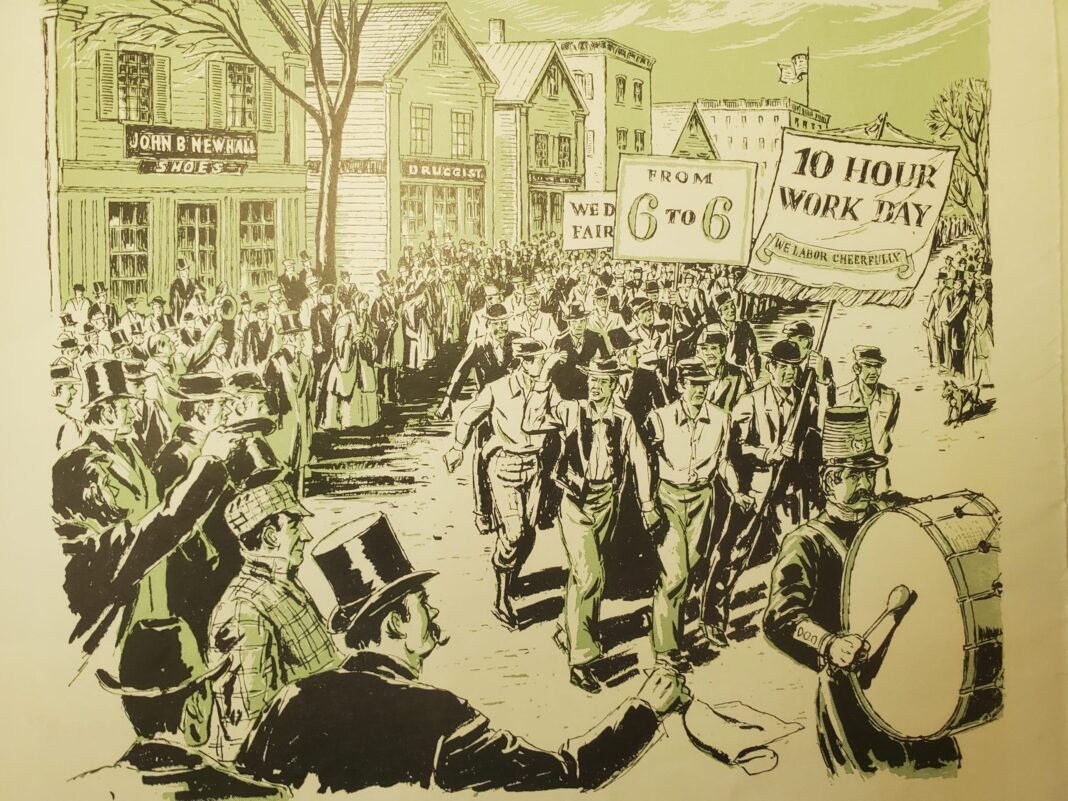Trenton has seen its fair share of workers banding together to fight for better wages, hours, and benefits leveraging strikes as a strategy in the toolkit of workers throughout the 1900s.
For Historic Trenton’s Day in the Life, we’re looking back through newspapers from the beginning and examining everyday problems, solutions, and needs during historic Trenton’s past. Today, we are looking at the history of some of the strikes in the city.
According to the Trenton Sunday Times Advertiser, the first recorded labor strike in Trenton was in 1835. Building trade workers sought to change the average work day to a ten-hour day to improve conditions.
Later, in the 1860s, the first pottery strike took place as workers fought for better wages, among other advancements.
Two decades later, Trenton began associating with the Knights of Labor, the first major labor organization in the United States, in 1882. A charter was granted for a lodge called Local Assembly, No. 1362, K. of L.
The assembly represented various branches of industry and trade, including rubber workers, potters, ironworkers, cigar makers, journalists, carpenters, printers, and plumbers.
The potter industry was doing well and had recovered from the early strikes, with businesses improving and wages going up. Then trouble struck in 1883.
According to A History of Trenton 1679 to 1929, “then came announcement again that wages were to be cut. Labor leaders contended there was absolutely no reason for this except the greed of the manufacturers. National labor organizers came here to secure some adjustment of the difficulty and the cause of industrial unionism was advanced.”
The strike continued through the winter when finally, in April, an agreement was reached by the men accepting an eight-per-cent slash in their wages.
According to The History of Trenton, James H. Mulheron became the principal keeper of the State Prison and later the United States marshal for this district and was a member of the committee that closed the deal. “He and his associates, as is often the case with peacemakers, were censured instead of praised, the workers feeling that they should have had greater concessions from the employers. It was at this time the pottery towns in the Ohio Valley gained their ascendency and replaced Trenton as the leading pottery center of America,” Writes A History of Trenton 1679 to 1929.
However, this was not the end of the Pottery industry. To learn more, check out this historic Trenton.
HISTORIC TRENTON’S DAY IN THE LIFE: The Rise and Fall of the Pottery Industry
Workers across industries continued to demand better from their employers. According to the Sunday Times advertisement, in 1904, Trenton was the center of the Rubber industry and, by nature, became the center of the first major strike in the industry.
The workers fought a losing battle, and in 1904 Samuel Gompers, president of the AFL, came to Trenton to address the striking rubber workers. The union lost the strike, and the defeat led to the dismemberment of the National Rubber Union. It would be 35 years until we’re able to reorganize.
Workers continued to fight after referendums created better hours, safety, and benefits during the 1930s and 40s. In 1958, 100 brick workers walked off the job to raise their wages by 25 cents to add to their 3.97 an hour pay. The walkout held up work across the county at St. Mary’s Cathedral; Public Serves Duck Island generator and two Hamilton schools.
Sometimes it didn’t end well, like in 1971. According to the Trentonian, S&M Electric Industries Strikers learned they could not return to work after the business became a “Motor and Appliance repair shop with service” and dropped the contracting profession.
Strikes end in deals and handshakes, arrests, loss of job, and union busts. The visions of a past city are vivid as we continue to take the journey down Historic Trenton’s Day in the Life.





